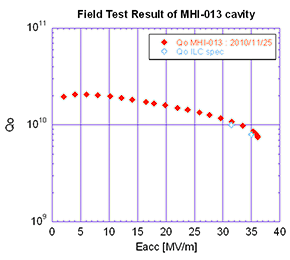Topics
Japanese 9-cell SCRF cavity meets ILC specifications
1 Dec 2010

The Japanese cavity achieved an important milestone. On 25 November, it fulfilled, for the first time, the production specifications for the International Linear Collider (ILC) in a vertical test conducted at KEK's Superconducting RF Test Facility (STF). The cavity, called MHI-013 is the 13th in a series of nine-cell cavities fabricated by Mitsubishi Heavy Industries Co., Ltd. It demonstrated the accelerating gradient of 31.5 megavolts per meter (MV/m) with an unloaded quality factor (Q0) over 1×1010, and 35 MV/m with Q0 over 0.8×1010. As 31.5 MV/m is the targeted operating gradient of the ILC, 35 MV/m allows ten percent margin for this operating gradient.
Accelerating gradient and Q0 are two important parameters for realizing the ILC. The accelerating gradient is a measure of how much an accelerator can increase the energy of a particle over a given stretch. The higher the gradient, the shorter the accelerator, and hence, cheaper the system can be built. Q0 is the quality factor of a cavity, where a higher Q indicates a lower rate of power loss relative to the stored energy.
Designing and fabricating an optimal cavity is not simple. The 1 meter-long cavities are made of nine cells, and inner surfaces of those cells are polished to provide micrometer-level smoothness, and are made free of impurities. Tiny surface blemishes or dust could cause cavities to lose the superconductivity, and prevent the cavities from sustaining the electric field needed for accelerating particles.
A series of cavity inner surface treatment process for MHI-013 including electro-chemical etching, high pressure water rinsing and dust-free assembly, were carried out at the electro-polishing facility at the STF of KEK.